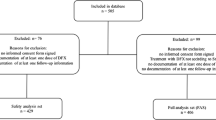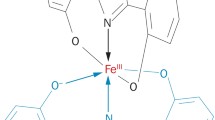Abstract
Background
Deferasirox (DFX) is an oral iron chelator with an established dose-dependent efficacy in transfusion-related iron overload. Whereas emerging long-term data confirm the safety of the drug, with transient moderate elevation of serum creatinine level, several authors have reported renal tubular dysfunction. The aim of this study was to evaluate tubular and glomerular function before and after the initiation of DFX therapy in a pediatric patient population.
Methods
Ten children (4 girls, mean age 12.4 ± 3.9 years) enrolled in a routine blood transfusion program were treated with 24.8 ± 9.6 mg/kg per day of DFX, and renal function was assessed before and 17.2 ± 8.9 months after the initiation of DFX therapy.
Results
Prior to treatment with DFX, all patients had a normal glomerular function rate (GFR) (125 ± 15 ml/min per 1.73 m2) and normal tubular function. Following the initiation of DFX therapy, the GFR decreased by approximately 20 % with one patient with a GFR of <80 mL/min per 1.73 m2 and seven patients with a GFR of <100 mL/min per 1.73 m2. Two patients experienced a generalized proximal tubular dysfunction whereas nine patients presented at least one sign of proximal tubular dysfunction.
Conclusions
Renal toxicity is a frequent adverse event of DFX treatment, presenting as both glomerular and proximal dysfunction. A routine renal assessment is therefore required to prevent chronic kidney disease that may result from prolonged tubular injury.




Similar content being viewed by others
Abbreviations
- DFX:
-
Deferasirox
- eGFR:
-
Estimated glomerular filtration rate
- FEUA:
-
Fractional excretion of uric acid
- GFR:
-
Glomerular filtration rate
- iGFR:
-
True glomerular filtration rate (inulin clearance)
- Pcr:
-
Plasma creatinine
- PO4 :
-
Plasma phosphate
- TmP/GFR:
-
Tubular maximal phosphate reabsorption corrected by GFR
- UA:
-
Plasma Uric acid
- Ualb/Ucr:
-
Urinary albumin to creatinine ratio
- Ualb:
-
Albuminuria
- UCa/Ucr:
-
Urinary calcium to creatinine ratio
- UMg/Ucr:
-
Urinary magnesium to creatinine ratio
- β2 M:
-
Urinary β2-microglobulin level
References
Hershko C (2007) Iron loading and its clinical implications. Am J Hematol 82:1147–1148
Porter JB (2007) Concepts and goals in the management of transfusional iron overload. Am J Hematol 82:1136–1139
Lindsey WT, Olin BR (2007) Deferasirox for transfusion-related iron overload: a clinical review. Clin Ther 29:2154–2166
Delea TE, Edelsberg J, Sofrygin O, Thomas SK, Baladi JF, Phatak PD, Coates TD (2007) Consequences and costs of noncompliance with iron chelation therapy in patients with transfusion-dependent thalassemia: a literature review. Transfusion 47:1919–1929
Galanello R, Piga A, Forni GL, Bertrand Y, Foschini ML, Bordone E, Leoni G, Lavagetto A, Zappu A, Longo F, Maseruka H, Hewson N, Sechaud R, Belleli R, Alberti D (2006) Phase II clinical evaluation of deferasirox, a once-daily oral chelating agent, in pediatric patients with beta-thalassemia major. Haematologica 91:1343–1351
Vichinsky E, Onyekwere O, Porter J, Swerdlow P, Eckman J, Lane P, Files B, Hassell K, Kelly P, Wilson F, Bernaudin F, Forni GL, Okpala I, Ressayre-Djaffer C, Alberti D, Holland J, Marks P, Fung E, Fischer R, Mueller BU, Coates T (2007) A randomised comparison of deferasirox versus deferoxamine for the treatment of transfusional iron overload in sickle cell disease. Br J Haematol 136:501–508
Taher A, El-Beshlawy A, Elalfy MS, Al Zir K, Daar S, Habr D, Kriemler-Krahn U, Hmissi A, Al Jefri A (2009) Efficacy and safety of deferasirox, an oral iron chelator, in heavily iron-overloaded patients with beta-thalassaemia: the ESCALATOR study. Eur J Haematol 82:458–465
Cappellini MD, Cohen A, Piga A, Bejaoui M, Perrotta S, Agaoglu L, Aydinok Y, Kattamis A, Kilinc Y, Porter J, Capra M, Galanello R, Fattoum S, Drelichman G, Magnano C, Verissimo M, Athanassiou-Metaxa M, Giardina P, Kourakli-Symeonidis A, Janka-Schaub G, Coates T, Vermylen C, Olivieri N, Thuret I, Opitz H, Ressayre-Djaffer C, Marks P, Alberti D (2006) A phase 3 study of deferasirox (ICL670), a once-daily oral iron chelator, in patients with beta-thalassemia. Blood 107:3455–3462
Cappellini MD (2008) Long-term efficacy and safety of deferasirox. Blood Rev 22[Suppl 2]:S35–S41
Brosnahan G, Gokden N, Swaminathan S (2008) Acute interstitial nephritis due to deferasirox: a case report. Nephrol Dial Transplant 23:3356–3358
Yew CT, Talaulikar GS, Falk MC, Clayton P, D'Rozario J, Brown M (2010) Acute interstitial nephritis secondary to deferasirox causing acute renal injury needing short-term dialysis. Nephrology 15:377
Papadopoulos N, Vasiliki A, Aloizos G, Tapinis P, Kikilas A (2010) Hyperchloremic metabolic acidosis due to deferasirox in a patient with beta thalassemia major. Ann Pharmacother 44:219–221
Rafat C, Fakhouri F, Ribeil JA, Delarue R, Le Quintrec M (2009) Fanconi syndrome due to deferasirox. Am J Kidney Dis 54:931–934
Grange S, Bertrand DM, Guerrot D, Eas F, Godin M (2010) Acute renal failure and Fanconi syndrome due to deferasirox. Nephrol Dial Transplant 25:2376–2378
Even-Or E, Becker-Cohen R, Miskin H (2010) Deferasirox treatment may be associated with reversible renal Fanconi syndrome. Am J Hematol 85:132–134
Yacobovich J, Stark P, Barzilai-Birenbaum S, Krause I, Pazgal I, Yaniv I, Tamary H (2010) Acquired proximal renal tubular dysfunction in beta-thalassemia patients treated with deferasirox. J Pediatr Hematol Oncol 32:564–567
Wei HY, Yang CP, Cheng CH, Lo FS (2011) Fanconi syndrome in a patient with beta-thalassemia major after using deferasirox for 27 months. Transfusion 51:949–954
Rheault MN, Bechtel H, Neglia JP, Kashtan CE (2010) Reversible Fanconi syndrome in a pediatric patient on deferasirox. Pediatr Blood Cancer 56:674–676
Ghuysen MS (2005) Dangerous drugs for the kidney. Arch Pediatr 12:728–730
Angelucci E, Barosi G, Camaschella C, Cappellini MD, Cazzola M, Galanello R, Marchetti M, Piga A, Tura S (2008) Italian Society of Hematology practice guidelines for the management of iron overload in thalassemia major and related disorders. Haematologica 93:741–752
Andre JL, Deschamps JP, Gueguen R (1980) Arterial blood pressure in 17,067 children and adolescents. Variation with age and height. Arch Fr Pediatr 37:477–482
Dubourg L, Hadj-Aissa A, Ferrier B (2010) Adaptation of an enzymatic polyfructosan assay to clinical practice. Anal Biochem 405:266–268
Du Bois D, Du Bois EF (1989) A formula to estimate the approximate surface area if height and weight be known. 1916. Nutrition 5:303–311
Schwartz GJ, Munoz A, Schneider MF, Mak RH, Kaskel F, Warady BA, Furth SL (2009) New equations to estimate GFR in children with CKD. J Am Soc Nephrol 20:629–637
Aldudak B, Karabay Bayazit A, Noyan A, Ozel A, Anarat A, Sasmaz I, Kilinc Y, Gali E, Anarat R, Dikmen N (2000) Renal function in pediatric patients with beta-thalassemia major. Pediatr Nephrol 15:109–112
Smolkin V, Halevy R, Levin C, Mines M, Sakran W, Ilia K, Koren A (2008) Renal function in children with beta-thalassemia major and thalassemia intermedia. Pediatr Nephrol 23:1847–1851
Sumboonnanonda A, Malasit P, Tanphaichitr VS, Ong-ajyooth S, Sunthornchart S, Pattanakitsakul S, Petrarat S, Assateerawatt A, Vongjirad A (1998) Renal tubular function in beta-thalassemia. Pediatr Nephrol 12:280–283
Koliakos G, Papachristou F, Koussi A, Perifanis V, Tsatra I, Souliou E, Athanasiou M (2003) Urine biochemical markers of early renal dysfunction are associated with iron overload in beta-thalassaemia. Clin Lab Haematol 25:105–109
Economou M, Printza N, Teli A, Tzimouli V, Tsatra I, Papachristou F, Athanassiou-Metaxa M (2010) Renal dysfunction in patients with beta-thalassemia major receiving iron chelation therapy either with deferoxamine and deferiprone or with deferasirox. Acta Haematol 123:148–152
Quinn CT, Johnson VL, Kim HY, Trachtenberg F, Vogiatzi MG, Kwiatkowski JL, Neufeld EJ, Fung E, Oliveri N, Kirbys M, Giardina PJ (2011) Renal dysfunction in patients with thalassemia. Br J Haematol 153:111–117
Koren G, Bentur Y, Strong D, Harvey E, Klein J, Baumal R, Spielberg SP, Freedman MH (1989) Acute changes in renal function associated with deferoxamine therapy. Am J Dis Child 143:1077–1080
Novartis Pharmaceuticals Corporation (2009) Exjade (deferasirox). Prescribing information. Available at: http://www.pharma.us.novartis.com/product/pi/pdf/exjade
Cianciulli P, Sollecito D, Sorrentino F, Forte L, Gilardi E, Massa A, Papa G, Carta S (1994) Early detection of nephrotoxic effects in thalassemic patients receiving desferrioxamine therapy. Kidney Int 46:467–470
Nisbet-Brown E, Olivieri NF, Giardina PJ, Grady RW, Neufeld EJ, Sechaud R, Krebs-Brown AJ, Anderson JR, Alberti D, Sizer KC, Nathan DG (2003) Effectiveness and safety of icl670 in iron-loaded patients with thalassaemia: A randomised, double-blind, placebo-controlled, dose-escalation trial. Lancet 361:1597–1602
Nick H, Acklin P, Lattmann R, Buehlmayer P, Hauffe S, Schupp J, Alberti D (2003) Development of tridentate iron chelators: from desferrithiocin to ICL670. Curr Med Chem 10:1065–1076
Piga A, Galanello R, Forni GL, Cappellini MD, Origa R, Zappu A, Donato G, Bordone E, Lavagetto A, Zanaboni L, Sechaud R, Hewson N, Ford JM, Opitz H, Alberti D (2006) Randomized phase II trial of deferasirox (Exjade, ICL670), a once-daily, orally-administered iron chelator, in comparison to deferoxamine in thalassemia patients with transfusional iron overload. Haematologica 91:873–880
Cappellini MD, Bejaoui M, Agaoglu L, Canatan D, Capra M, Cohen A, Drelichman G, Economou M, Fattoum S, Kattamis A, Kilinc Y, Perrotta S, Piga A, Porter JB, Griffel L, Dong V, Clark J, Aydinok Y (2011) Iron chelation with deferasirox in adult and pediatric patients with thalassemia major: efficacy and safety during 5 years' follow-up. Blood 118:884–893
Cappellini MD, Galanello R, Piga A, Cohen A, Kattamis A, Aydinok Y, Williamson P, Rojkjaer L, Porter JB (2008) Efficacy and safety of deferasirox (Exjade®) with up to 4.5 years of treatment in patients with thalassemia major: a pooled analysis (abstract). Blood 112:5411
Piga A, Forni GL, Kattamis A, Kattamis C, Aydinok Y, Rodriguez M, Rojkjaer L, Galanello R (2008) Deferasirox (Exjade®) in pediatric patients with β-thalassemia: update of 4.7-year efficacy and safety from extension studies (abstract). Blood 112:3883
Papassotiriou I, Margeli A, Hantzi E, Delaporta P, Sergounioti A, Goussetis E, Ladis V, Kattamis A (2010) Cystatin C levels in patients with beta-thalassemia during deferasirox treatment. Blood Cells Mol Dis 44:152–155
Bergeron RJ, Wiegand J, McManis JS, Bharti N, Singh S (2008) Desferrithiocin analogues and nephrotoxicity. J Med Chem 51:5993–6004
Baum M (2010) Renal Fanconi syndrome secondary to deferasirox: where there is smoke there is fire. J Pediatr Hematol Oncol 32:525–526
Conflict of interest
None.
Author information
Authors and Affiliations
Corresponding author
Rights and permissions
About this article
Cite this article
Dubourg, L., Laurain, C., Ranchin, B. et al. Deferasirox-induced renal impairment in children: an increasing concern for pediatricians. Pediatr Nephrol 27, 2115–2122 (2012). https://doi.org/10.1007/s00467-012-2170-4
Received:
Revised:
Accepted:
Published:
Issue Date:
DOI: https://doi.org/10.1007/s00467-012-2170-4




